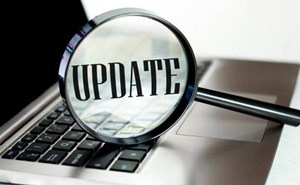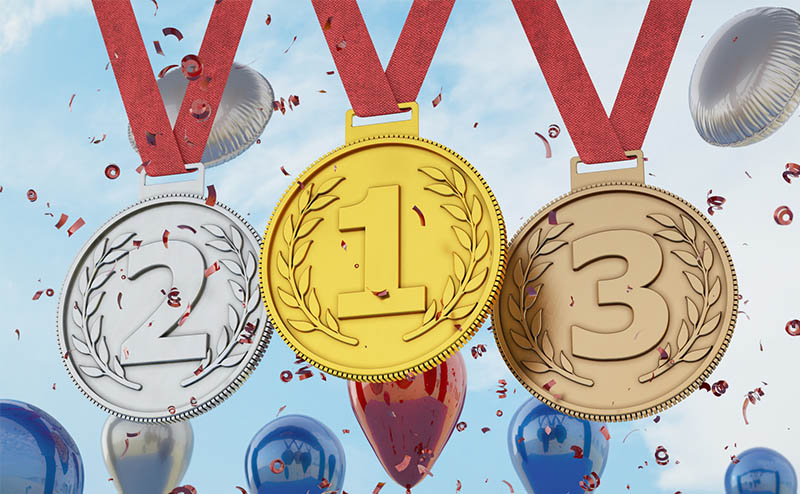
Sound Waves & Sirens: Creating a SonOlympics for EMS Teams Without Prior Ultrasound Training
Heesun Choi, DO
Nathan A. Friedman, MD
Ami Kurzweil, MD
As a new and enthusiastic member of the ACEP Prehospital, Austere, and Tactical Ultrasound Subcommittee, I’m thrilled to contribute to our mission of expanding the use of ultrasound in prehospital and resource-limited settings. One way I’ve embraced this mission is through designing a high-energy, low-barrier event I call the SonOlympics – an immersive, team-based ultrasound competition for EMS providers with zero prior ultrasound training.1,2,3
In many rural or austere environments, transfer times often exceed two hours. With prolonged times to definitive care, early identification of life-threatening conditions like tamponade, pneumothorax, or intra-abdominal bleeding can improve outcomes. Equipping prehospital teams with the training to perform basic point of care ultrasound (POCUS) skills like eFAST, especially in cardiac arrest, can help guide resuscitation efforts, inform transport decisions, and even support earlier termination of efforts when appropriate.1,2,4
Teaching these skills doesn’t have to be dry or intimidating. Enter SonOlympics: a fast-paced, gamified competitive workshop designed to empower EMS providers with no prior ultrasound training by making ultrasound fun, approachable, and unforgettable.
Where It All Happened
The first SonOlympics were proudly held in September 2022 at the International Trauma Life Support (ITLS) Arizona Conference. This gathering brought together first responders and EMS personnel from across the state and served as the perfect stage to showcase how POCUS can be taught in an engaging, high-yield format.
How to Build a SonOlympics
- Plan the Logistics
- Estimate total number of learners
- Choose the competition duration (2–4 hours ideal)
- Form teams: groups of 2–3
- Set up 3–5 stations depending on number of teams
- Use a timer: 20 min per station, 5 min for transitions, 20 min for scoring/awards
- Find your instructors: minimum instructors = number of stations + 1 moderator Instructor experience can range from medical students to techs, residents, attendings — we even had a high school student assist with an ultrasound-guided IV station!
- Station Design: Objectives & Learning Outcomes
SonOlympics 2022 Stations
- Ultrasight Station
Objective: Develop fundamental probe handling and image acquisition skills
What they learned: Probe orientation, fanning, tilting, and micromovements by trying to recreate example images (eg, gallbladder) while wearing kaleidoscope glasses. This helped build muscle memory and spatial awareness.
- eFAST Station
Objective: Learn to perform an extended FAST (eFAST) exam
What they learned: How to identify free fluid in the abdomen and thorax, recognize pericardial effusion, and differentiate normal vs. abnormal findings.
- IV Access Station
Objective: Perform ultrasound-guided peripheral IV placement
What they learned: Needle-probe alignment, vein identification, and dynamic guidance — essential for patients with difficult IV access. One of the most popular and confidence-building stations.
- Abdominal Imaging Station
Objective: Recognize abdominal anatomy on ultrasound
What they learned: Identify organs like liver, kidney, and bladder; adjust depth/gain settings; and navigate real anatomy using a hands-on approach.
SonOlympics 2023 Stations
Along with repeat eFAST, ultrasound IV, and Ultrasight stations, we added a number of additional stations to enhance training and retention.
- Foreign Body Safari
Objective: Identify foreign objects embedded in tissue using ultrasound
What they learned: Image interpretation and spatial scanning by locating animal figures hidden in opaque gelatin. Reinforced probe control and foreign body recognition.
- Guess That Image Station
Objective: Improve diagnostic recognition of POCUS clips
What they learned: How to visually identify organs (heart, lung, abdomen) and differentiate normal from abnormal findings like free fluid or pneumothorax. Boosted pattern recognition.
- Scoring and Awards
- Teams named and decorated themselves — Bonus points for decoration and creativity!
- Each station used a clear scoring system (time, accuracy, correct identification)
- Prizes like AirPods and gift cards were awarded to top-performing teams
Who Attended?
Participants ranged from a variety of EMS fields, including firefighters, paramedics, law enforcement, medics, and cave rescue personnel — most with no prior ultrasound experience. After the competition, participants could confidently distinguish free fluid from cysts, identify pneumothorax using lung sliding/barcode signs, and successfully insert peripheral IVs. Their enthusiasm and newfound skills were a reminder that ultrasound is a tool anyone can learn — and that it belongs in the hands of first responders.
Why It Matters
Hands-on ultrasound training like SonOlympics has been shown to quickly boost EMS providers’ confidence and skills.1,4
POCUS has proven effective for patient triage and may be particularly valuable during CPR, especially in remote or austere environments with prolonged transport times.⁵ In prehospital settings, POCUS can be taught through targeted education and hands-on training, allowing EMS personnel to identify life-threatening pathologies.⁶ Importantly, studies show that incorporating POCUS into prehospital care does not cause significant delays on scene.⁶
By enhancing clinical decision-making, POCUS helps tailor patient care before arrival to the hospital.⁵ While already a cornerstone tool in EDs, POCUS is increasingly being adopted internationally in prehospital systems.⁷ The growing body of evidence supports this trend and highlights the need for high-quality, accessible education and ongoing skill development.⁷
The SonOlympics competition was created to raise awareness of prehospital POCUS and to demonstrate how approachable and impactful this training can be. I hope to continue developing structured educational initiatives that support quality assurance, skill retention, and a strong standard of care—whether in the ED or out in the field.⁷
As the ACEP Prehospital, Austere, and Tactical Ultrasound Subcommittee works on white papers, toolkits and device guides, SonOlympics complements those efforts by creating a fun, easy-to-replicate way to spark interest and deliver meaningful education in a concise and effective environment 3– bringing ultrasound skills directly to the front lines.8
If you’d like to host a SonOlympics or adapt it for your agency, reach out!
About the Author
Dr. Heesun Choi graduated from Touro University Nevada College of Osteopathic Medicine and completed her emergency medicine residency with Midwestern University at Kingman Regional Medical Center. She went on to complete an ultrasound fellowship at UC Irvine Health.
Beginning with the COVID-19 pandemic, Dr. Choi focused on developing ultrasound education for faculty, residents, medical students, and EMS providers while serving as an ultrasound director. Her work has taken her from busy trauma centers to small, critical access hospitals – including a four-bed facility on Catalina Island and a remote Native American reservation hospital in Northern Arizona.
Dr. Choi is now part of the emergency medicine core faculty at Eisenhower Health, where she also supports the ultrasound fellowship program and is working to build an EMS ultrasound education initiative for the surrounding desert region – while still working in a rural Arizona hospital with limited resources.
She’s grateful to be part of the ACEP Prehospital, Austere, and Tactical Ultrasound Subcommittee, whose guidance has helped shape her efforts to expand meaningful ultrasound training. No matter the setting, she remains committed to showing up, scanning, and sharing what she loves about point-of-care ultrasound with anyone willing to learn.
SPECIAL THANKS TO
Mindray for the ultrasound machines for the games
KRMC EM Residents, Attendings and Medical Students
ITLS AZ Conference for inviting SonOlympics
All participants
References
- Nguyen CM, Hartmann K, Goodmurphy C, Flamm A. E-FAST ultrasound training curriculum for prehospital emergency medical service (EMS) clinicians. J Educ Teach Emerg Med. 2024;9(1):C41-C97.
- O'Connor L, Beth-Urhoy M, Allegra S, et al. A Novel Point-of-care Ultrasound Curriculum for Air Critical Care Personnel. West J Emerg Med. 2023;24(1):30-7.
- Russell FM, Lobo D, Herbert A, et al. Gamification of POCUS: Are Students Learning? West J Emerg Med. 2023;24(2):243-8.
- Workman A, Hecht C, Crawford C, et al. Can Firefighters be Taught Ultrasound? Am Surg. 2018;84(6):e192-e198.
- Vianen NJ, Van Lieshout EMM, Vlasveld KHA, et al. Impact of Point-of-Care Ultrasound on Prehospital Decision Making by HEMS Physicians in Critically Ill and Injured Patients: A Prospective Cohort Study. Prehosp Disaster Med. 2023;38(4):444-9.
- Engelen C, Haack J, Lämmermann D, et al. Implementing ultrasound in emergency medical services: assessing physician proficiency and training requirements. Scand J Trauma Resusc Emerg Med.2025;33:92.
- Amaral CB, Ralston DC, Becker TK. Prehospital point-of-care ultrasound: A transformative technology. SAGE Open Med. 2020 Jul 26;8:2050312120932706.
- Meadley B, Olaussen A, Delorenzo A, et al. Educational standards for training paramedics in ultrasound: a scoping review. BMC Emerg Med. 2017;17(1):18.
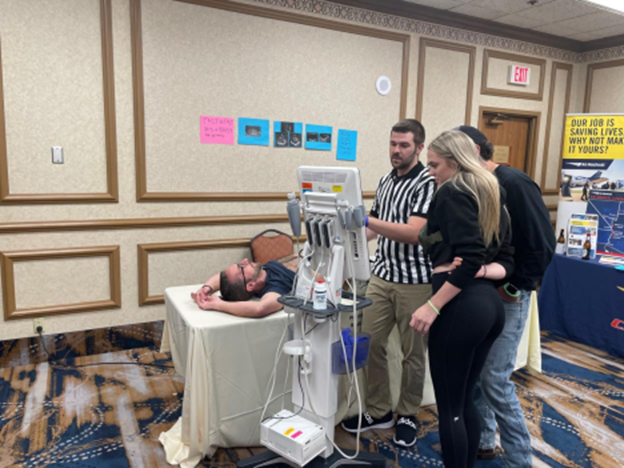 2023 SonOlympics - FAST eFAST station
2023 SonOlympics - FAST eFAST station
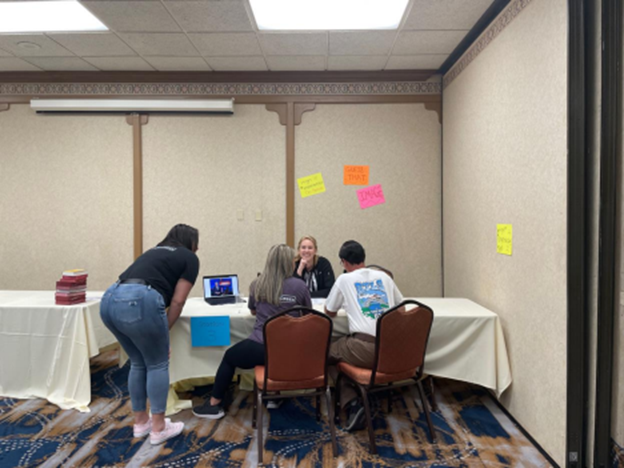 2023 SonOlympics - Guess that image station
2023 SonOlympics - Guess that image station
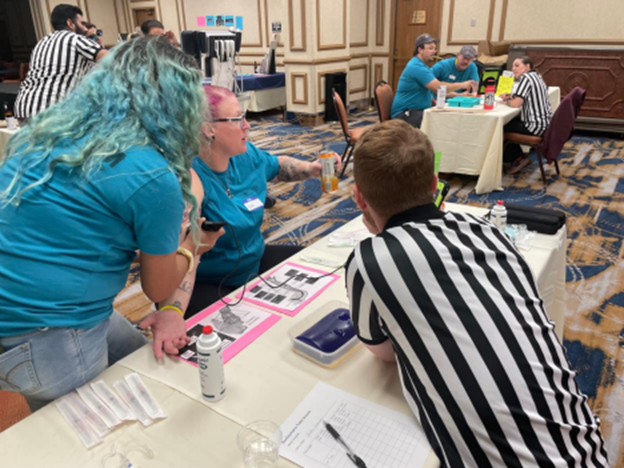 2023 SonOlympics - IV Poker Station
2023 SonOlympics - IV Poker Station
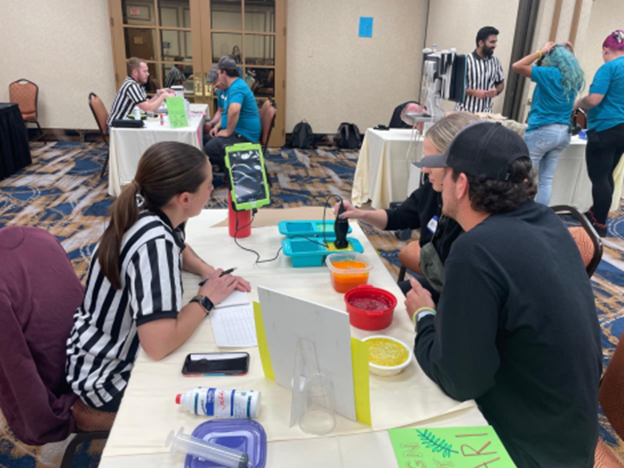 2023 SonOlympics - Foreign body safari station
2023 SonOlympics - Foreign body safari station
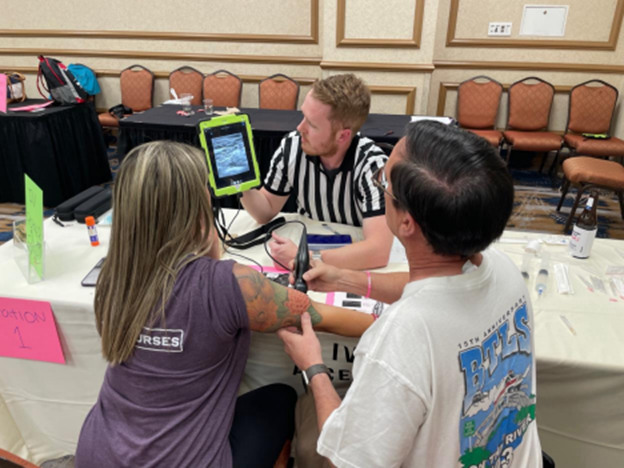 2023 SonOlympics - IV poker station
2023 SonOlympics - IV poker station
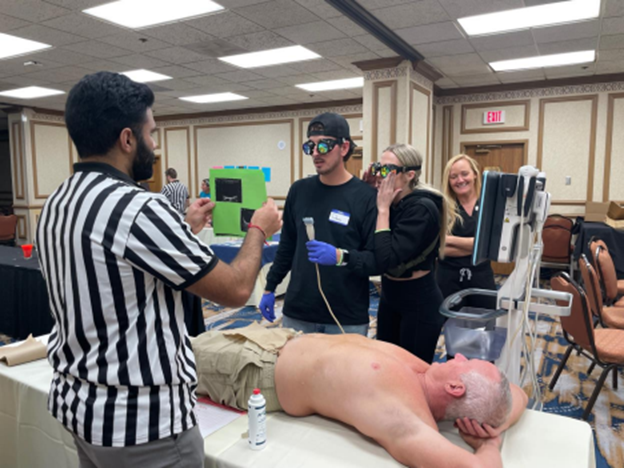 2023 SonOlympics - Ultrasight station
2023 SonOlympics - Ultrasight station
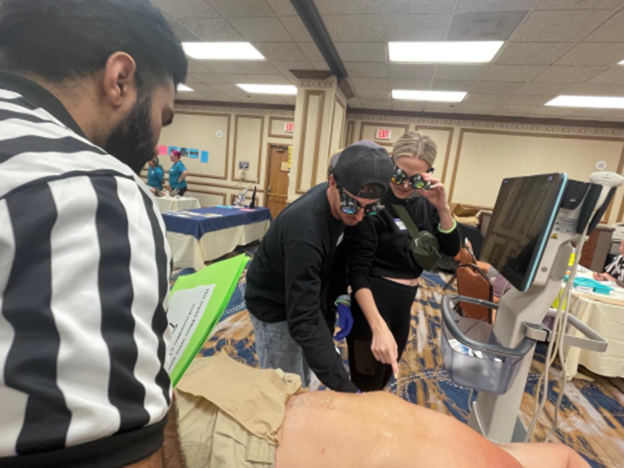 2023 SonOlympics - Ultrasight station
2023 SonOlympics - Ultrasight station
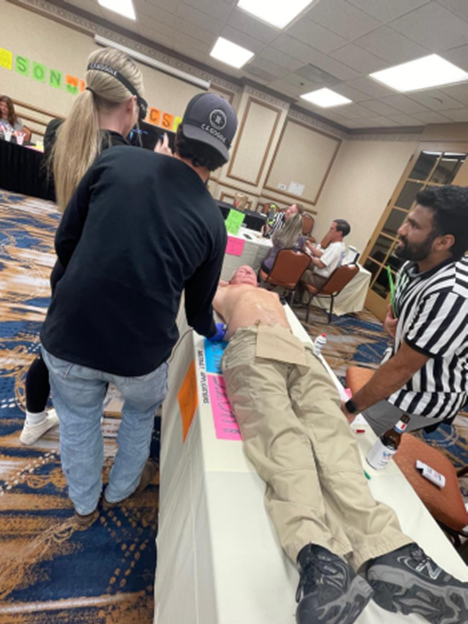 2023 SonOlympics - Ultrasight station
2023 SonOlympics - Ultrasight station
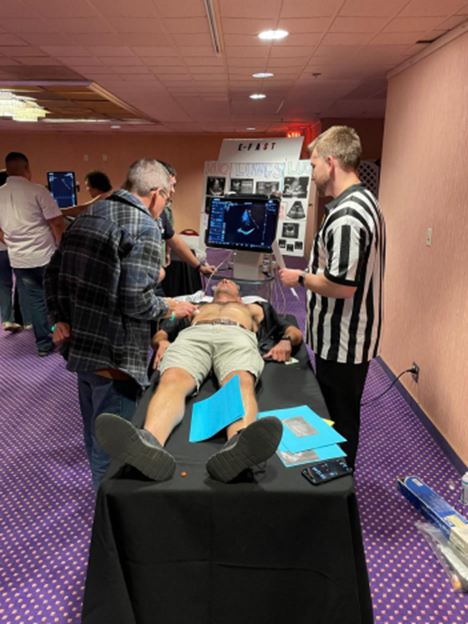 2022 SonOlympics – eFAST Station
2022 SonOlympics – eFAST Station
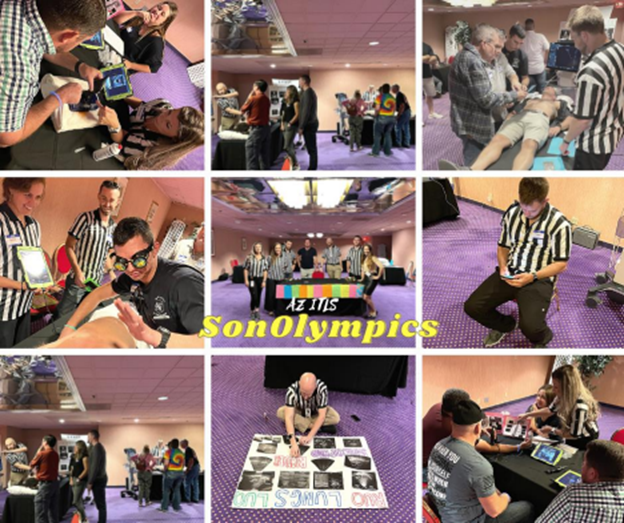 2022 SonOlympics
2022 SonOlympics


